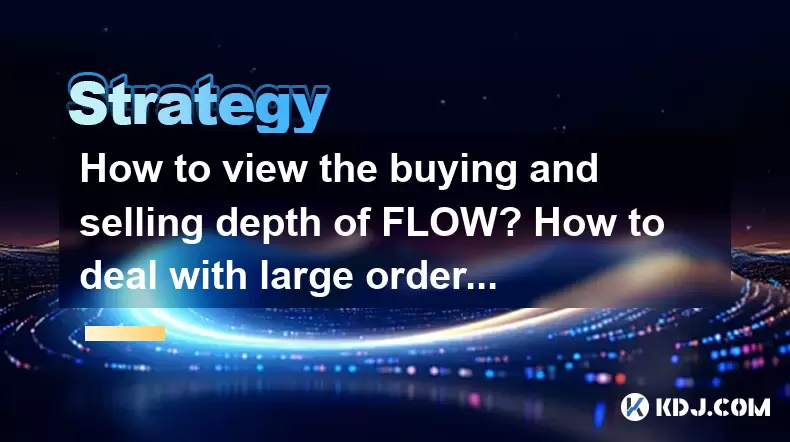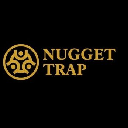-
 bitcoin
bitcoin $114684.631706 USD
-0.87% -
 ethereum
ethereum $4228.677447 USD
1.58% -
 bnb
bnb $1294.880693 USD
-1.16% -
 tether
tether $1.000819 USD
-0.02% -
 xrp
xrp $2.605138 USD
2.79% -
 solana
solana $209.908690 USD
5.89% -
 usd-coin
usd-coin $0.999903 USD
-0.03% -
 dogecoin
dogecoin $0.213423 USD
2.93% -
 tron
tron $0.322721 USD
-0.10% -
 cardano
cardano $0.727247 USD
3.66% -
 hyperliquid
hyperliquid $42.339456 USD
6.05% -
 chainlink
chainlink $19.910811 USD
5.16% -
 ethena-usde
ethena-usde $1.000557 USD
0.00% -
 stellar
stellar $0.349734 USD
2.69% -
 bitcoin-cash
bitcoin-cash $543.848687 USD
-0.21%
How to view the buying and selling depth of FLOW? How to deal with large orders?
To view FLOW's buying and selling depth, use the order book on exchanges like Binance, Coinbase Pro, or Kraken, and consider using iceberg or TWAP orders for large trades.
May 07, 2025 at 07:22 pm

Understanding the buying and selling depth of a cryptocurrency like FLOW is crucial for making informed trading decisions. The depth of market shows the volume of buy and sell orders at different price levels, helping traders understand the liquidity and potential price movements. For handling large orders, it's important to use strategies that minimize market impact and slippage.
How to View the Buying and Selling Depth of FLOW
To view the buying and selling depth of FLOW, you can use various cryptocurrency trading platforms that provide order book data. Here's how you can do it on some popular exchanges:
- On Binance:
- Navigate to the FLOW trading page.
- Look for the Order Book tab, usually located on the right side of the trading interface.
- The order book will display a list of buy orders (bids) and sell orders (asks) with their respective quantities and prices.
- You can often switch between a table view and a depth chart view. The depth chart visually represents the cumulative volume of buy and sell orders at different price levels.
- On Coinbase Pro:
- Go to the FLOW trading page.
- Find the Order Book section, typically on the left side of the screen.
- Similar to Binance, you'll see a list of bids and asks, and you can switch to a depth chart for a visual representation.
- On Kraken:
- Access the FLOW trading pair.
- The Order Book is usually located on the right side of the trading interface.
- You can view the list of bids and asks, and toggle to a depth chart for a graphical view.
Interpreting the Depth Chart
The depth chart is a valuable tool for understanding market sentiment and potential price movements. Here's how to interpret it:
- Green Area: Represents the cumulative volume of buy orders (bids). The wider the green area at a certain price level, the more buy orders there are at that price.
- Red Area: Represents the cumulative volume of sell orders (asks). A wider red area at a certain price level indicates more sell orders at that price.
- Price Levels: The horizontal axis shows different price levels, while the vertical axis shows the cumulative volume of orders.
By analyzing the depth chart, you can identify support and resistance levels, which are price points where a significant amount of buy or sell orders are concentrated.
Dealing with Large Orders
Handling large orders requires careful planning to minimize market impact and slippage. Here are some strategies to consider:
Iceberg Orders: These allow you to place a large order that only shows a small portion of the total order size to the market. This can help prevent other traders from reacting to your large order and moving the market against you.
- On exchanges that support iceberg orders, you can set the display quantity to a smaller amount than your total order size.
- The exchange will automatically replenish the displayed quantity as it gets filled until the entire order is executed.
Time-Weighted Average Price (TWAP) Orders: These orders are executed over a specified period, spreading the order across multiple smaller trades to reduce market impact.
- Choose the TWAP order type on supported exchanges.
- Set the start time, end time, and total quantity for the order.
- The exchange will automatically calculate and execute smaller trades at regular intervals within the specified time frame.
Volume-Weighted Average Price (VWAP) Orders: Similar to TWAP, but these orders are executed based on the volume of trades in the market, aiming to match the average price of trades during the execution period.
- Select the VWAP order type on supported exchanges.
- Specify the total quantity and execution period.
- The exchange will execute the order in smaller chunks, aiming to achieve a price close to the VWAP.
Manual Slicing: If advanced order types are not available, you can manually break down your large order into smaller pieces and execute them over time.
- Determine the total quantity you want to buy or sell.
- Decide on the size of each slice and the time interval between slices.
- Place smaller orders at regular intervals, monitoring the market impact and adjusting your strategy as needed.
Monitoring Market Impact
When dealing with large orders, it's essential to monitor the market impact of your trades. Here's how you can do it:
- Check Price Movements: After placing a slice of your order, observe any immediate price movements. If the price moves significantly against your order, you may need to adjust the size or timing of subsequent slices.
- Use Trading Bots: Some traders use automated trading bots to execute large orders and monitor market impact. These bots can be programmed to adjust order sizes and timing based on market conditions.
- Analyze Order Book Changes: Continuously monitor the order book to see if your order is causing other traders to adjust their orders. A sudden increase in sell orders after you place a buy order, for example, could indicate that your order is impacting the market.
Executing Large Orders on Different Exchanges
Different exchanges may offer different tools and features for handling large orders. Here's how you can execute large orders on some popular exchanges:
- On Binance:
- Use Iceberg Orders to hide the total order size.
- Utilize OCO (One Cancels the Other) Orders to manage risk by setting a stop-loss and take-profit at the same time.
- Consider using Binance's API to automate the execution of large orders with trading bots.
- On Coinbase Pro:
- Place Limit Orders at different price levels to spread out your order execution.
- Use Stop Orders to manage risk and protect against adverse price movements.
- Take advantage of Coinbase Pro's API for more advanced order execution strategies.
- On Kraken:
- Use Dark Pool Liquidity to execute large orders with minimal market impact.
- Place Post-Only Orders to ensure your order does not immediately affect the market.
- Utilize Kraken's API for automated trading and large order execution.
FAQs
Q: Can I use the same strategy for handling large orders on all exchanges?A: While some strategies like manual slicing can be used on any exchange, others like iceberg orders and TWAP/VWAP orders depend on the specific features offered by each platform. Always check the available order types and tools on your chosen exchange before planning your strategy.
Q: How can I minimize slippage when executing large orders?A: To minimize slippage, consider using iceberg orders to hide the total order size, breaking down your order into smaller slices, and executing them over time. Additionally, using TWAP or VWAP orders can help achieve a more favorable average price.
Q: Are there any tools or services that can help automate the execution of large orders?A: Yes, many exchanges offer APIs that allow you to connect trading bots or custom scripts to automate the execution of large orders. Services like 3Commas, Cryptohopper, and HaasOnline provide trading bots that can be configured to handle large orders with various strategies.
Q: How can I assess the liquidity of FLOW before placing a large order?A: To assess the liquidity of FLOW, look at the order book depth on your chosen exchange. A deeper order book with significant volumes of buy and sell orders at various price levels indicates higher liquidity. Additionally, you can use market data tools and indicators like the bid-ask spread and trading volume to gauge liquidity.
Disclaimer:info@kdj.com
The information provided is not trading advice. kdj.com does not assume any responsibility for any investments made based on the information provided in this article. Cryptocurrencies are highly volatile and it is highly recommended that you invest with caution after thorough research!
If you believe that the content used on this website infringes your copyright, please contact us immediately (info@kdj.com) and we will delete it promptly.
- XRP Price Prediction: Weekend Rollercoaster or Rally?
- 2025-10-12 08:45:16
- Bittensor (TAO): Super Bullish Signals Point to Potential 2x Rally
- 2025-10-11 10:25:12
- Silver Price Correction: Navigating the Dip & Identifying Key SEO Keywords
- 2025-10-11 10:25:12
- Decoding Crypto Trends: Bittensor's Bull Run, Cardano's Dip, and LivLive's Presale Buzz in 'Uptober 2025'
- 2025-10-12 08:45:16
- MoonBull: The Crypto Meme Coin Promising 1000x Gains?
- 2025-10-11 10:30:01
- Crypto Payroll Revolution: Stablecoins, Altcoins, and the Future of Salary Payments
- 2025-10-11 10:30:01
Related knowledge

Practical parameter settings for a Bitcoin multi-timeframe moving average system
Sep 18,2025 at 10:54pm
Optimizing Timeframe Combinations for Bitcoin Trading1. Selecting appropriate timeframes is crucial when building a multi-timeframe moving average sys...

How can I filter out false breakouts in Dogecoin high-frequency trading?
Sep 22,2025 at 01:00am
Understanding False Breakouts in Dogecoin Trading1. A false breakout occurs when Dogecoin's price appears to move beyond a defined support or resistan...

Techniques for identifying tops and bottoms in the Bitcoin on-chain NVT model
Sep 20,2025 at 07:54pm
Understanding the NVT Model in Bitcoin Analysis1. The Network Value to Transactions (NVT) ratio is often described as the 'P/E ratio' of the cryptocur...

What does the surge in open interest in Bitcoincoin futures mean?
Sep 20,2025 at 11:18pm
Understanding the Surge in Dogecoin Futures Open Interest1. A surge in open interest within Dogecoin futures indicates a growing number of active cont...

How can I use the Ethereum USDT premium to gauge market sentiment?
Sep 18,2025 at 11:55pm
Understanding the Ethereum USDT Premium1. The Ethereum USDT premium refers to the price difference between USDT (Tether) traded on Ethereum-based plat...

What should I do if Ethereum staking yields decline?
Sep 20,2025 at 06:18am
Understanding the Causes Behind Declining Ethereum Staking Yields1. The Ethereum network transitioned to a proof-of-stake consensus mechanism with the...

Practical parameter settings for a Bitcoin multi-timeframe moving average system
Sep 18,2025 at 10:54pm
Optimizing Timeframe Combinations for Bitcoin Trading1. Selecting appropriate timeframes is crucial when building a multi-timeframe moving average sys...

How can I filter out false breakouts in Dogecoin high-frequency trading?
Sep 22,2025 at 01:00am
Understanding False Breakouts in Dogecoin Trading1. A false breakout occurs when Dogecoin's price appears to move beyond a defined support or resistan...

Techniques for identifying tops and bottoms in the Bitcoin on-chain NVT model
Sep 20,2025 at 07:54pm
Understanding the NVT Model in Bitcoin Analysis1. The Network Value to Transactions (NVT) ratio is often described as the 'P/E ratio' of the cryptocur...

What does the surge in open interest in Bitcoincoin futures mean?
Sep 20,2025 at 11:18pm
Understanding the Surge in Dogecoin Futures Open Interest1. A surge in open interest within Dogecoin futures indicates a growing number of active cont...

How can I use the Ethereum USDT premium to gauge market sentiment?
Sep 18,2025 at 11:55pm
Understanding the Ethereum USDT Premium1. The Ethereum USDT premium refers to the price difference between USDT (Tether) traded on Ethereum-based plat...

What should I do if Ethereum staking yields decline?
Sep 20,2025 at 06:18am
Understanding the Causes Behind Declining Ethereum Staking Yields1. The Ethereum network transitioned to a proof-of-stake consensus mechanism with the...
See all articles










































































